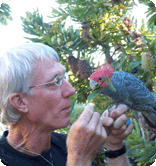Spray millet for parrots

Hi EB, I was just wondering, are millet sprays good for parrots? I have been told by some they are high in fat and bad for my pet, but I recently read a book that said they were low fat and good as a treat. Would you recommend millet? Thanks.

Dear Friend, Millet sprays (white proso is the most common) are fine foods for parrots, parakeets, lovebirds, finches, canaries, etc.
They contain roughly four percent fat depending on which analysis one refers to--much less than the 40% fat content of safflowers and sunflowers which are seeds for large oil-ingesting hookbills like macaws, greys, capes, etc. Millet is not a complete food, of course, and needs to be fed with a variety of other foods including grated vegetables, fruit with pips, extruded pellets, sprouted grains, and the like.
Inexperienced budgerigar owners in the past used to hang millet sprays in their bird's cage every day because the parakeet "loved them." In fact, the budgie was eating and eating and eating to try and satisfy nutrient cravings not available in 100% millet, so would end up overweight and usually die early.
It is important to seek out a fresh supplier of millet.....the best seeds are golden in color and very shiny on the stalk. They make a fine foraging food for all psittacines as they take a long time to crunch all the seeds and are easy to hold clumps in the claws for the parrots that can do so. We typically cut an eight-inch spray into four to six pieces for feeding our birds. One can also take a spring clothespin and attach the spray stem to the side of a cage for the birds to nibble at. Once or twice a week is sufficient in a good mixed diet. If you are in doubt about dry looking millet sprays in a store, an attempt to sprout a few small clusters will tell you if they are still viable and "alive."
Millet sprays are one of the first items we offer young starting-to-eat baby parrots when they become interested in chewing. It teaches them about textures and seed food extraction and is fun to crunch, even though they actually ingest little at first.
Another excellent way of giving millet spray is to germinate it for 24 hours weighted down in a pan of clean water, rinsing four or five times to keep the water fresh. The seeds will "pop" a white nub which will grow into a sprout if the spray is kept damp but not soaking for another day or so, even in the refrigerator. This changes the fat-sugar-carbohydrate content of the stored dry seed and makes it even more nutritious once the birds get used to eating it soft.
Happy Feeding, EB

































